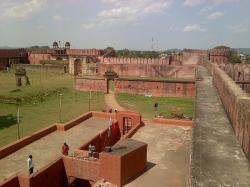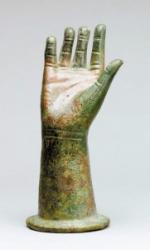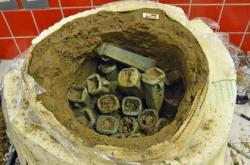INSTITUT SUPERIEUR D'ANTHROPOLOGIE
INSTITUTE OF ANTHROPOLOGY
ONLINE COURSES / COURS A DISTANCE
NEW OPEN COURSE : JANUARY 2013
HRM 104 : INTRODUCTION TO INTANGIBLE CULTURAL HERITAGE
REGISTER NOW
INDE –  Nagpur - The Mumbai-based State Archaeology and Museums Directorate is well known for its apathy towards historic structures, but this attitude touched nadir in the case of Nagardhan Fort. TOI has written how negligence of officials led to the collapse of a wall on the fort's western side. However, instead of repairing it, city-based archaeology officials p The pictures taken by TOI and recent ones clicked by experts clearly reveal how officials razed the entire structure above the wall that caved in on October 7.ulled down the remaining structure, including petals on the top, with the help of a bulldozer. The Wakatak era fort is believed to have been built between 300 and 400BC by Gond kings, but during the reign of Bhonsalas, it was renovated on regular basis, till about 300-400 years back.
Nagpur - The Mumbai-based State Archaeology and Museums Directorate is well known for its apathy towards historic structures, but this attitude touched nadir in the case of Nagardhan Fort. TOI has written how negligence of officials led to the collapse of a wall on the fort's western side. However, instead of repairing it, city-based archaeology officials p The pictures taken by TOI and recent ones clicked by experts clearly reveal how officials razed the entire structure above the wall that caved in on October 7.ulled down the remaining structure, including petals on the top, with the help of a bulldozer. The Wakatak era fort is believed to have been built between 300 and 400BC by Gond kings, but during the reign of Bhonsalas, it was renovated on regular basis, till about 300-400 years back.
http://timesofindia.indiatimes.com/city/nagpur/Archaeology-officials-pull-down-remaining-part-of-Nagardhan-Fort-wall/articleshow/17201919.cms
LIBAN –  Saida - This remarkably lifelike, 7-inch-tall bronze right hand dating to sometime in the first centuries C.E. was crafted to capture every detail of the human hand, from the slight curvatures of the palm and fingers to the delicate skin creases around the finger joints and wrist. According to the Greek inscription incised on the forearm, the hand was dedicated by “Zenon and Nikousa” who “made a vow” and “received satisfaction.” Although the exact archaeological context of the find is unknown (it was discovered during a 19th-century French expedition to Saida [Biblical Sidon] in modern Lebanon), the inscription, together with the hand’s exceptional craftsmanship, suggest Zenon and Nikousa set up the hand, possibly in a temple or house of healing, as a votive offering to a deity who had answered their prayers. Why the two chose a hand as an offering remains a mystery. In the Greco-Roman world, such “anatomical votives” were often given as offerings to Asclepius, the Greek god of healing, for having cured an illness or injury to a particular body part. In the Biblical and Semitic traditions, however, the right hand had more solemn associations and was typically given to guarantee oaths and seal contracts.
Saida - This remarkably lifelike, 7-inch-tall bronze right hand dating to sometime in the first centuries C.E. was crafted to capture every detail of the human hand, from the slight curvatures of the palm and fingers to the delicate skin creases around the finger joints and wrist. According to the Greek inscription incised on the forearm, the hand was dedicated by “Zenon and Nikousa” who “made a vow” and “received satisfaction.” Although the exact archaeological context of the find is unknown (it was discovered during a 19th-century French expedition to Saida [Biblical Sidon] in modern Lebanon), the inscription, together with the hand’s exceptional craftsmanship, suggest Zenon and Nikousa set up the hand, possibly in a temple or house of healing, as a votive offering to a deity who had answered their prayers. Why the two chose a hand as an offering remains a mystery. In the Greco-Roman world, such “anatomical votives” were often given as offerings to Asclepius, the Greek god of healing, for having cured an illness or injury to a particular body part. In the Biblical and Semitic traditions, however, the right hand had more solemn associations and was typically given to guarantee oaths and seal contracts.
http://www.biblicalarchaeology.org/daily/ancient-cultures/ancient-near-eastern-world/worldwide-saida-lebanon/
ROYAUME UNI –  Jersey - An x-ray of the Bronze Age pot found in a Jersey field last month, carried out at the island’s airport, has found a further 21 axeheads in a discovery which could shed new light on the way people lived 3,000 years ago. The original excavation, carried out after metal detectorist Ken Rive reported the find on a plot of land in Trinity, confirmed two socketed axeheads inside the damaged ancient pot. Air pockets between the axes suggest that soil may have concealed the rest of the weapons as the pot gradually decayed. “A trial x-ray fluorescence scan was carried out by staff from Cranfield University on the first two axes,” said a statement by Olga Finch, Jersey Heritage’s Curator of Archaeology, and Neil Mahrer, the Conservator for the group. “This shows that they contain a very high lead content – almost 55 percent. “This throws some doubt on whether these axes were actually functional tools, as that amount of lead would not have given the axe a very sharp edge. “Maybe, therefore, they were objects of prestige – something to own and show off.” All the axes are believed to date from the latter part of the era. They will now be removed from the pot for further investigation.
Jersey - An x-ray of the Bronze Age pot found in a Jersey field last month, carried out at the island’s airport, has found a further 21 axeheads in a discovery which could shed new light on the way people lived 3,000 years ago. The original excavation, carried out after metal detectorist Ken Rive reported the find on a plot of land in Trinity, confirmed two socketed axeheads inside the damaged ancient pot. Air pockets between the axes suggest that soil may have concealed the rest of the weapons as the pot gradually decayed. “A trial x-ray fluorescence scan was carried out by staff from Cranfield University on the first two axes,” said a statement by Olga Finch, Jersey Heritage’s Curator of Archaeology, and Neil Mahrer, the Conservator for the group. “This shows that they contain a very high lead content – almost 55 percent. “This throws some doubt on whether these axes were actually functional tools, as that amount of lead would not have given the axe a very sharp edge. “Maybe, therefore, they were objects of prestige – something to own and show off.” All the axes are believed to date from the latter part of the era. They will now be removed from the pot for further investigation.
http://www.culture24.org.uk/history%20%26%20heritage/archaeology/art408817